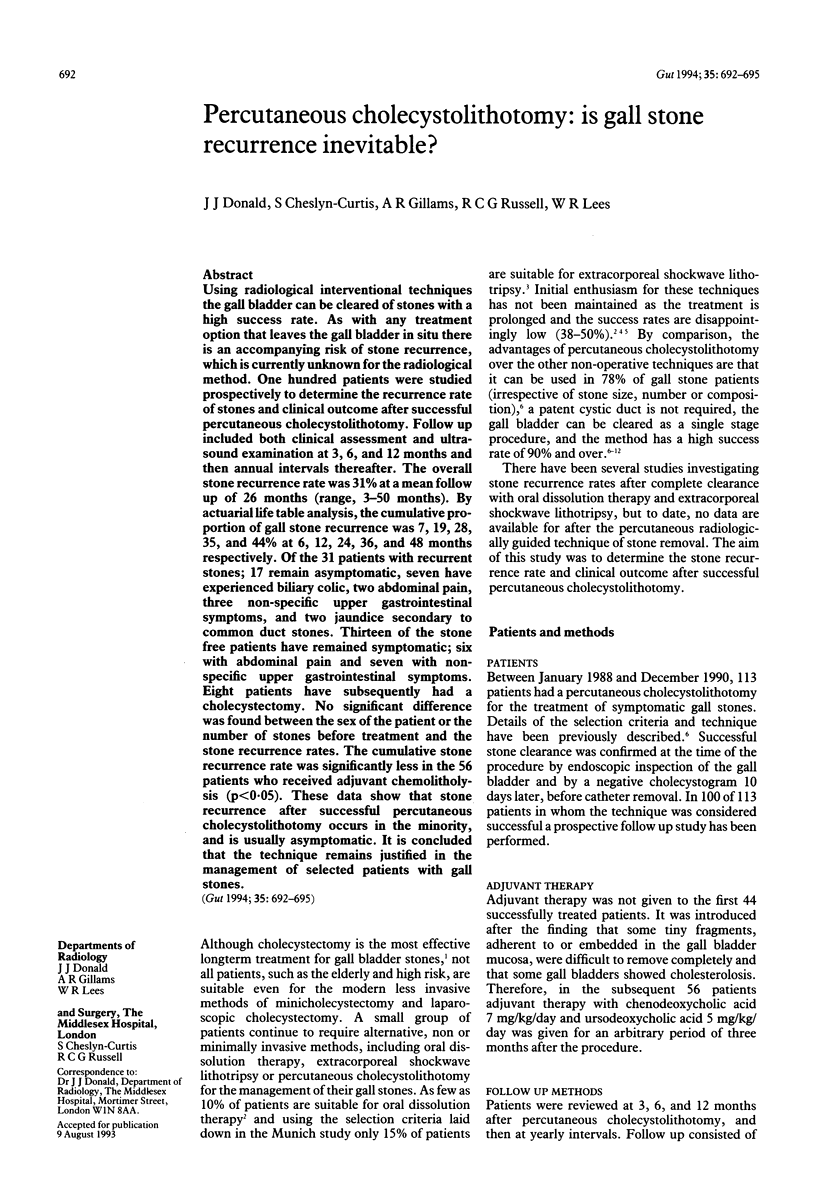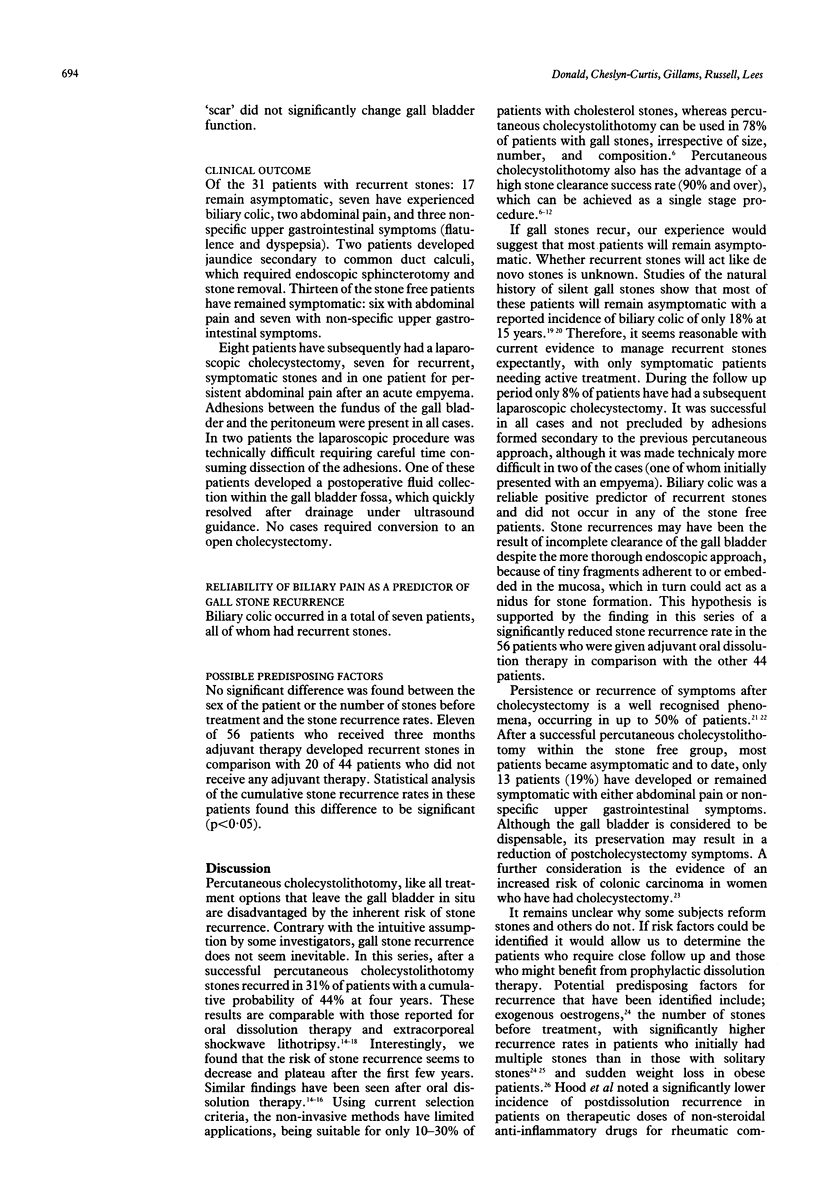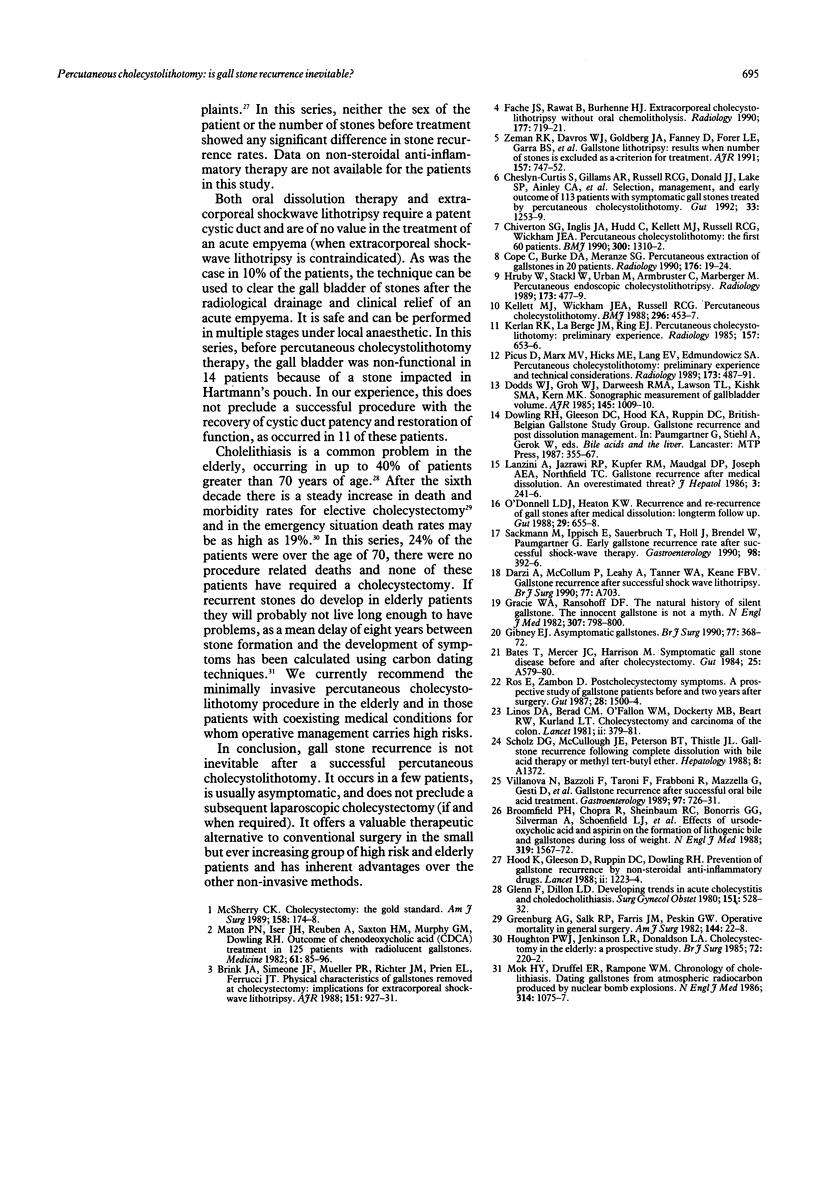Abstract
Using radiological interventional techniques the gall bladder can be cleared of stones with a high success rate. As with any treatment option that leaves the gall bladder in situ there is an accompanying risk of stone recurrence, which is currently unknown for the radiological method. One hundred patients were studied prospectively to determine the recurrence rate of stones and clinical outcome after successful percutaneous cholecystolithotomy. Follow up included both clinical assessment and ultrasound examination at 3, 6, and 12 months and then annual intervals thereafter. The overall stone recurrence rate was 31% at a mean follow up of 26 months (range, 3-50 months). By actuarial life table analysis, the cumulative proportion of gall stone recurrence was 7, 19, 28, 35, and 44% at 6, 12, 24, 36, and 48 months respectively. Of the 31 patients with recurrent stones; 17 remain asymptomatic, seven have experienced biliary colic, two abdominal pain, three non-specific upper gastrointestinal symptoms, and two jaundice secondary to common duct stones. Thirteen of the stone free patients have remained symptomatic; six with abdominal pain and seven with nonspecific upper gastrointestinal symptoms. Eight patients have subsequently had a cholecystectomy. No significant difference was found between the sex of the patient or the number of stones before treatment and the stone recurrence rates. The cumulative stone recurrence rate was significantly less in the 56 patients who received adjuvant chemolitholysis (p < 0.05). These data show that stone recurrence after successful percutaneous cholecystolithotomy occurs in the minority, and is usually asymptomatic. It is concluded that the technique remains justified in the management of selected patients with gall stones.
Full text
PDF



Selected References
These references are in PubMed. This may not be the complete list of references from this article.
- Brink J. A., Simeone J. F., Mueller P. R., Richter J. M., Prien E. L., Ferrucci J. T. Physical characteristics of gallstones removed at cholecystectomy: implications for extracorporeal shock-wave lithotripsy. AJR Am J Roentgenol. 1988 Nov;151(5):927–931. doi: 10.2214/ajr.151.5.927. [DOI] [PubMed] [Google Scholar]
- Broomfield P. H., Chopra R., Sheinbaum R. C., Bonorris G. G., Silverman A., Schoenfield L. J., Marks J. W. Effects of ursodeoxycholic acid and aspirin on the formation of lithogenic bile and gallstones during loss of weight. N Engl J Med. 1988 Dec 15;319(24):1567–1572. doi: 10.1056/NEJM198812153192403. [DOI] [PubMed] [Google Scholar]
- Cheslyn-Curtis S., Gillams A. R., Russell R. C., Donald J. J., Lake S. P., Ainley C. A., Hatfield A. R., Lees W. R. Selection, management, and early outcome of 113 patients with symptomatic gall stones treated by percutaneous cholecystolithotomy. Gut. 1992 Sep;33(9):1253–1259. doi: 10.1136/gut.33.9.1253. [DOI] [PMC free article] [PubMed] [Google Scholar]
- Chiverton S. G., Inglis J. A., Hudd C., Kellett M. J., Russell R. C., Wickham J. E. Percutaneous cholecystolithotomy: the first 60 patients. BMJ. 1990 May 19;300(6735):1310–1312. doi: 10.1136/bmj.300.6735.1310. [DOI] [PMC free article] [PubMed] [Google Scholar]
- Cope C., Burke D. R., Meranze S. G. Percutaneous extraction of gallstones in 20 patients. Radiology. 1990 Jul;176(1):19–24. doi: 10.1148/radiology.176.1.2353089. [DOI] [PubMed] [Google Scholar]
- Dodds W. J., Groh W. J., Darweesh R. M., Lawson T. L., Kishk S. M., Kern M. K. Sonographic measurement of gallbladder volume. AJR Am J Roentgenol. 1985 Nov;145(5):1009–1011. doi: 10.2214/ajr.145.5.1009. [DOI] [PubMed] [Google Scholar]
- Fache J. S., Rawat B., Burhenne H. J. Extracorporeal cholecystolithotripsy without oral chemolitholysis. Radiology. 1990 Dec;177(3):719–721. doi: 10.1148/radiology.177.3.2243975. [DOI] [PubMed] [Google Scholar]
- Gibney E. J. Asymptomatic gallstones. Br J Surg. 1990 Apr;77(4):368–372. doi: 10.1002/bjs.1800770405. [DOI] [PubMed] [Google Scholar]
- Glenn F., Dillon L. D. Developing trends in acute cholecystitis and choledocholithiasis. Surg Gynecol Obstet. 1980 Oct;151(4):528–532. [PubMed] [Google Scholar]
- Gracie W. A., Ransohoff D. F. The natural history of silent gallstones: the innocent gallstone is not a myth. N Engl J Med. 1982 Sep 23;307(13):798–800. doi: 10.1056/NEJM198209233071305. [DOI] [PubMed] [Google Scholar]
- Greenburg A. G., Saik R. P., Farris J. M., Peskin G. W. Operative mortality in general surgery. Am J Surg. 1982 Jul;144(1):22–28. doi: 10.1016/0002-9610(82)90596-7. [DOI] [PubMed] [Google Scholar]
- Hood K., Gleeson D., Ruppin D. C., Dowling R. H. Prevention of gallstone recurrence by non-steroidal anti-inflammatory drugs. Lancet. 1988 Nov 26;2(8622):1223–1225. doi: 10.1016/s0140-6736(88)90812-4. [DOI] [PubMed] [Google Scholar]
- Houghton P. W., Jenkinson L. R., Donaldson L. A. Cholecystectomy in the elderly: a prospective study. Br J Surg. 1985 Mar;72(3):220–222. doi: 10.1002/bjs.1800720327. [DOI] [PubMed] [Google Scholar]
- Hruby W., Stackl W., Urban M., Armbruster C., Marberger M. Percutaneous endoscopic cholecystolithotripsy. Work in progress. Radiology. 1989 Nov;173(2):477–479. doi: 10.1148/radiology.173.2.2678260. [DOI] [PubMed] [Google Scholar]
- Kellett M. J., Wickham J. E., Russell R. C. Percutaneous cholecystolithotomy. Br Med J (Clin Res Ed) 1988 Feb 13;296(6620):453–455. doi: 10.1136/bmj.296.6620.453. [DOI] [PMC free article] [PubMed] [Google Scholar]
- Kerlan R. K., Jr, LaBerge J. M., Ring E. J. Percutaneous cholecystolithotomy: preliminary experience. Radiology. 1985 Dec;157(3):653–656. doi: 10.1148/radiology.157.3.4059554. [DOI] [PubMed] [Google Scholar]
- Lanzini A., Jazrawi R. P., Kupfer R. M., Maudgal D. P., Joseph A. E., Northfield T. C. Gallstone recurrence after medical dissolution. An overestimated threat? J Hepatol. 1986;3(2):241–246. doi: 10.1016/s0168-8278(86)80033-2. [DOI] [PubMed] [Google Scholar]
- Linos D., Beard C. M., O'Fallon W. M., Dockerty M. B., Beart R. W., Jr, Kurland L. T. Cholecystectomy and carcinoma of the colon. Lancet. 1981 Aug 22;2(8243):379–381. doi: 10.1016/s0140-6736(81)90829-1. [DOI] [PubMed] [Google Scholar]
- McSherry C. K. Cholecystectomy: the gold standard. Am J Surg. 1989 Sep;158(3):174–178. doi: 10.1016/0002-9610(89)90246-8. [DOI] [PubMed] [Google Scholar]
- Mok H. Y., Druffel E. R., Rampone W. M. Chronology of cholelithiasis. Dating gallstones from atmospheric radiocarbon produced by nuclear bomb explosions. N Engl J Med. 1986 Apr 24;314(17):1075–1077. doi: 10.1056/NEJM198604243141703. [DOI] [PubMed] [Google Scholar]
- O'Donnell L. D., Heaton K. W. Recurrence and re-recurrence of gall stones after medical dissolution: a longterm follow up. Gut. 1988 May;29(5):655–658. doi: 10.1136/gut.29.5.655. [DOI] [PMC free article] [PubMed] [Google Scholar]
- Picus D., Marx M. V., Hicks M. E., Lang E. V., Edmundowicz S. A. Percutaneous cholecystolithotomy: preliminary experience and technical considerations. Radiology. 1989 Nov;173(2):487–491. doi: 10.1148/radiology.173.2.2798880. [DOI] [PubMed] [Google Scholar]
- Ros E., Zambon D. Postcholecystectomy symptoms. A prospective study of gall stone patients before and two years after surgery. Gut. 1987 Nov;28(11):1500–1504. doi: 10.1136/gut.28.11.1500. [DOI] [PMC free article] [PubMed] [Google Scholar]
- Sackmann M., Ippisch E., Sauerbruch T., Holl J., Brendel W., Paumgartner G. Early gallstone recurrence rate after successful shock-wave therapy. Gastroenterology. 1990 Feb;98(2):392–396. doi: 10.1016/0016-5085(90)90830-t. [DOI] [PubMed] [Google Scholar]
- Villanova N., Bazzoli F., Taroni F., Frabboni R., Mazzella G., Festi D., Barbara L., Roda E. Gallstone recurrence after successful oral bile acid treatment. A 12-year follow-up study and evaluation of long-term postdissolution treatment. Gastroenterology. 1989 Sep;97(3):726–731. doi: 10.1016/0016-5085(89)90644-6. [DOI] [PubMed] [Google Scholar]
- Zeman R. K., Davros W. J., Goldberg J. A., Fanney D., Forer L. E., Garra B. S., Hayes W. S., Horii S. C., Cooper C. J., Silverman P. M. Gallstone lithotripsy: results when number of stones is excluded as a criterion for treatment. AJR Am J Roentgenol. 1991 Oct;157(4):747–752. doi: 10.2214/ajr.157.4.1892029. [DOI] [PubMed] [Google Scholar]


